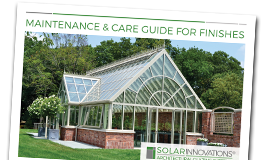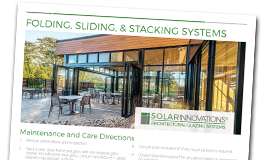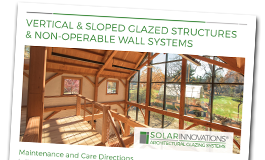A small amount of care and maintenance will go a long way in keeping your glazed system functioning properly and looking as fresh as the day it was installed. Built-up dirt and pollutants on the surface can accelerate the weathering and corrosion of your structure’s aluminum finish. Keeping the finish clean can help limit more costly maintenance in the future. Solar Innovations® does not recommend using harsh chemicals on any of our systems. A simple solution of water, vinegar and dish detergent will work well to clean the frame and glass. Operable windows and vent tracks need to be cleaned and checked regularly to maintain proper function. Motorized operations, such as ridge vents, will need occasional lubrication. Leaves and debris will also need to be removed from gutters. For greenhouses, always test your accessories as a new season approaches.
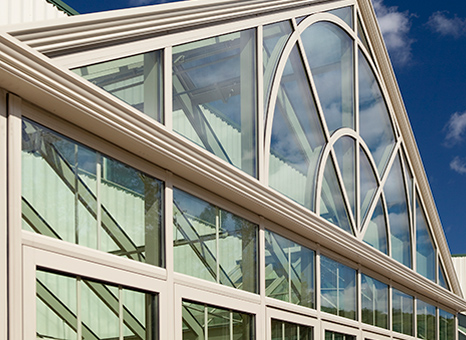
Glass Maintenance
We recommend cleaning the glass on a cloudy, mild day to minimize streaking. Do not use harsh chemicals; the simple solution provided below will keep your product looking and functioning great for years to come. The solution includes:
- 1 gallon of water
- 2 ounces of vinegar (more or less may be needed based on the mineral content of your water)
- 1-2 drops of dish detergent (adding more will make the water too foamy and will not provide the desired result)
Apply the mixture with a soft sponge and wash away the dirt. Use a rubber squeegee to remove excess moisture. It is not necessary to rinse the glass after washing, as this will only create streaks. The care and maintenance of your glass and finishes will vary according to your geographic location. Dirt and pollutants are more prevalent in urban areas and will require more frequent cleaning. Avoid cleaning in extreme weather conditions, such as intense heat or cold.

Aluminum Maintenance
Aluminum cleaning should be done on a cloudy, mild day and preferably at the same time as the glass. First, flush the surface with clean water — a hose is preferred on the exterior — to remove loose debris.
After flushing the surface, wash the aluminum using a sponge and mild soap or detergent that is safe for bare hands. A nylon cleaning pad may be necessary if the surface is heavily soiled. Be sure to thoroughly rinse the surface with clean water after washing.
Mineral spirits may be used to remove grease, sealants, or caulking compounds. Use a dilute solution of under 10% muriatic acid to remove concrete on the aluminum. Remove excess silicone with a razor blade, followed by an isopropyl alcohol wipe to remove residue.
Regular lubrication with a silicone spray or white lithium grease can help lubricate actuators and hinges in operational equipment. Tracks for operable doors and windows should be vacuumed regularly to prevent dirt and debris from collecting in the track. Finish with a Teflon or silicone spray in the track to keep it lubricated.
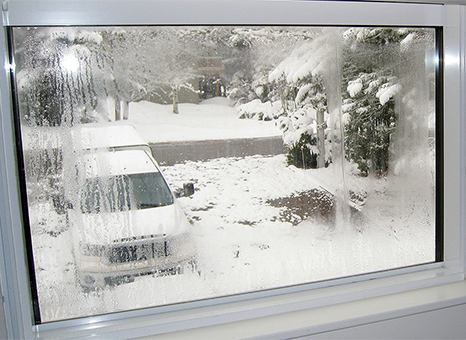
Preventing Moisture
Proper maintenance will ensure that moisture remains outside, where it belongs. Regularly checking and replacing the sealant will prevent moisture issues before they occur.
- To prevent mold, follow these precautions:
- Fix all leaks and seepage.
- Put a plastic cover over dirt in crawlspaces to prevent
moisture from the ground. - Use exhaust fans to remove moisture.
- Turn off appliances, such as humidifiers or kerosene
heaters, if moisture is present on glass. - Use dehumidifiers and air conditioners to reduce
moisture in the air.
Mold thrives when an organic food source is present, such as dirt, dust, or moisture. When mold becomes apparent, the first step is to find the source of growth and eliminate it. Mold can reappear in 72 hours under the right conditions. Controlling the moisture level will not only control mold growth but also prevent other unsightly conditions, such as condensation and water marks.
Care for your Finishes
Proper care of your product is necessary to protect its finish. Please follow the instructions below to extend the life and maintain the appearance of your product. FAILURE TO FOLLOW THESE INSTRUCTIONS VOIDS YOUR WARRANTY; it is recommended that you keep written maintenance records demonstrating your compliance with this Maintenance & Care Guide.
PRECAUTIONS
In addition to the instructions for individual finishes, please note the following:
- Properly protect the product from work in nearby areas. The products should be cleaned as soon as possible if concrete, plaster, chemical/sealant, paint or other foreign substances are splashed or sprayed onto the product. Quickly remove those substances, in accordance with the recommendation in this Guide, before they have a chance to damage the surface. The products should be inspected and cleaned at the time of overall project completion to ensure there are no foreign substances on it.
- Proximity of the products to sea air, salt spray, pool chemicals and similar environmental conditions can cause deterioration of the finish. Frequency of cleaning should be increased in these conditions, as needed, to maintain the finishes.
- With any of our finishes, be cautious in applying cleaning techniques or products that can damage the surface. Testing of cleaning methods at an inconspicuous location is recommended to be sure it does not damage the surface.
- Power washing should be avoided since it can damage gaskets and seals.
- Finishes can be damaged by interior areas subject to high humidity and condensation. If condensation is noticed on interior surfaces of the product, consult proper experts to eliminate the condensation through ventilation or other appropriate techniques.
Please call our Warranty Department at 570-915-1500 with any questions or in the event of any uncertainty about when and how to clean our finishes. Depending on your location, our Service Department may also be available to provide regular preventive maintenance to your products.

Painted Surfaces (Kynar 500® or Hylar 5000® Fluoropolymer Spray Coatings)
Over time, painted surfaces may show signs of weathering, such as loss of gloss, chalking, or slight color change from being exposed to the elements. Cleaning these structures must be according to the outlined specifications in order to maintain their finish.
Cleaning Schedule
An annual cleaning of fluoropolymer spray coatings is necessary to extend coating life and remove build-ups of resins and other residues.
Cleaning Precautions
- Avoid strong solvent and abrasive-type cleaners.
- Remove heavy soils, such as oil, grease, tar, wax, etc., by wiping with a cloth soaked in mineral spirits. Wipe only contaminated areas; follow with detergent cleaning and rinse thoroughly.
Cleaning Procedures
Cleaning should be executed according to the following guidelines:
- Wash with plain water using a hose or pressure spray equipment.
- Use heavy duty dry powdered detergent combined with 1/3 cup of water when surfaces are heavily soiled.
- Use a soft bristled brush to make cleaning easier.
- Rinse with clean, cold water immediately after cleaning.
- Areas subject to high humidity levels can experience mildew growth, which should be removed using the following solution:
- 1/3 cup powdered laundry detergent
- 2/3 cup tri-sodium phosphate or TSP
- 1 quart sodium hypochlorite 5% solution
- 3 quarts water

Anodized Aluminum
Anodized aluminum is exceptionally resistant to corrosion, discoloration, and wear; however, its surface finish can be marred by harsh chemicals, abuse, or neglect.
Cleaning Schedule
All exterior surfaces collect varying amounts of soil and dirt, depending on their finish and the environmental conditions of their location. These factors determine the type and frequency of cleaning required.
Cleaning Precautions
Certain precautions must be taken when cleaning anodized aluminum surfaces. Aluminum finishes must first be identified to select the appropriate cleaning method.
- Never use aggressive alkaline or acid cleaners.
- Avoid cleaning hot or sun-heated surfaces, since chemical reactions will be highly accelerated and surface non-uniformity could occur.
- Strong organic solvents may extract stain-producing chemicals from sealants and may affect the function of sealants.
- Do not use strong cleaners on glass and other areas where the cleaner may come in contact with the aluminum.
- Abrasives or excessive abrasive rubbing should not be used, since it could damage the finish.
- Never use MEK (Methyl Ethyl Ketone) or similar solvents on anodized finishes protected by clear organic coatings, unless the coating has deteriorated and should be removed.
- Be sure to exercise extreme caution when using solvents, because they have the potential to damage organic sealants, gaskets, and finishes.
Cleaning Procedures
To clean your anodized structure, start at the top, and proceed downward. Rinse areas the width of the stage or scaffolding with a forceful water spray. Specifications for removing light and heavy soils are as follows:
Removing Light Soils
Washing should be done using uniform pressure, first horizontally, then vertically.
- Flush the surface with water using moderate pressure.
- If soil is still present after the surface dries, scrub the surface with a sponge while continuously spraying it with water.
- If dirt persists, use a mild detergent with a sponge.
- Thoroughly rinse the surface with clean water.
- Use MEK (Methyl Ethyl Ketone) or a similar solvent to remove oil, wax, polish, etc.
Removing Heavy Soils
Removing heavy surface soils may require the use of an abrasive cleaning pad.
- Thoroughly soak the pad with clean water or mild detergent.
- Hand scrub the surface with uniform pressure in the direction of the metal grain.
- Scrubbing with a nylon-cleaning pad impregnated with a surface protecting material is also recommended for stubborn stains.
- Thoroughly rinse the surface with clean water.
- Let the surface air dry or wipe it down with a lint-free cloth.
Removing Extreme Soils
You may need to use power-cleaning tools for unusually heavy soils on large areas.
- When using power tools, the surface must be continually flushed with clean water or a mild detergent to provide lubrication and a medium for carrying away the dirt.
- Rinse the area with clean water, and thoroughly scrub it with a stiff bristle brush after it has been washed by a machine.
- The surface may be air dried or wiped dry.
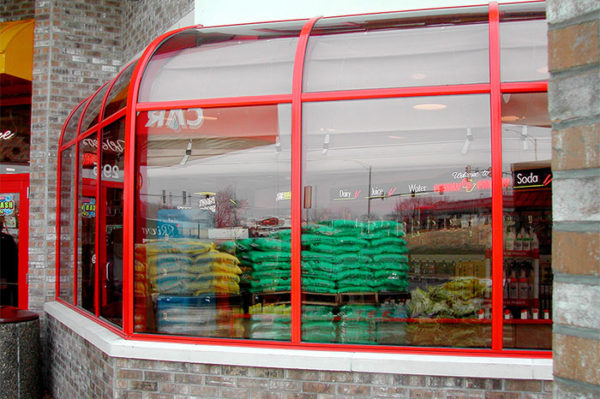
Powder Coatings
Over time, powder coatings may show signs of weathering, such as loss of gloss, chalking, and/or slight color change from being exposed to the elements. These structures must be cleaned according to the outlined specifications in order to maintain their finish.
Cleaning Schedule
Regular cleaning is required at least once a year. A simple regular cleaning will minimize the effects of weathering and remove dirt, grime, and other build-up. Regular cleaning frequency depends on factors including location, atmospheric pollution, and building protection.
Cleaning Precautions
- A suitability test must be taken for metallic powder coatings due to the danger of changes in a color tone.
- Avoid strong rubbing when cleaning the surface.
- Detergents must not be used at temperatures higher than 77° F.
- The maximum exposure period of detergents must not exceed one hour.
- Do not use solvents containing ester, ketones, alcohol, aromatics, ethylene glycol, or halogenated hydrocarbon.
- Do not use scratching or abrasive brushes, cloths or agents.
- Do not use strong acids, alkaline detergents, or similar products.
- Do not use detergents of unknown composition.
- Do not use stream-jet devices/power cleaning tools.
Cleaning Procedures
Cleaning should be executed according to the following guidelines:
- Use clean water with slight additives of neutral washing agents (pH 5-8) with the aid of non-abrasive soft cloths, rags, or industrial cotton.
- Use mineral spirits free of aromatics (chemical compounds) or alcohol to remove greasy, oily, or sooty substances. Adhesives, silicone cartouche, and adhesive tapes can also be removed this way.
- Joint sealants and other aids that come into contact with coated surfaces must be pH-neutral and free of paint-damaging substances, and they must first be subjected to a suitability test.
- Rinse with clean cold water immediately after every cleaning process.
- The entire cleaning process can be repeated, if necessary, after 24 hours.
Each coating is different; therefore it is essential to follow the exact specifications outlined for each type of finish. Properly cleaning and maintaining your structure’s surface will minimize the need for touch-ups in the future and extend the lifetime of the system.
Product Specific Maintenance & Care Directions

Folding, Sliding, and Stacking Systems
- Inspect your system regularly (at least monthly). Remove visible debris from all aspects of the system.
- Twice a year, clean frame and glass with non-abrasive glass cleaner, such as Sprayway Aerosol Glass Cleaner. For infill other than glass, consult a representative of the Solar Innovations® Service Department;— glass cleaners may damage surfaces.
- Sill systems, including weep holes, accessible pans and tracks should be cleaned at least annually and/or as buildup of debris is noticed. Clean dust-resistant strikes on floor if applicable.
- Inspect all gaskets annually; look for separation from frames and tightness of seals. Any worn or brittle gaskets or seals should be replaced.
- Inspect all sealant joints annually; look for separation and tightness of seals.
- Inspect intersections against adjacent structures for movement annually. Verify that sealant and flashings maintain a complete seal.
- Use only GE Silpruf sealant, available from Solar Innovations®, of the matching color to replace damaged sealant beads. Pre-wipe and clean with isopropyl alcohol before applying new silicone.
- Consult Solar Innovations® if any touch-up paint is required.
- Consult Solar Innovations® for any abnormalities in appearance or operation.
- Operate the door several times, noting any abnormalities or sticking points during operation. Consult Solar Innovations® if any such issues are found.
- Silicone spray or White Lithium Grease should be applied to hardware and trolleys annually.
- During visual inspection, note any irregular wearing of hardware, including hinges, trolleys, and wheels. Replacements will be necessary if the worn part is impacting product performance or operation.
- In areas of extremely high use or high debris areas, the track system should be inspected monthly.

Vertical & Sloped Glazed structures & Non-Operable Wall Systems
- Inspect your system regularly (at least monthly). Remove visible debris from all aspects of the system, including all weepholes, accessible pans and tracks.
- Twice a year, clean frame and glass with non-abrasive glass cleaner. For glazing other than glass, consult manufacturer — glass cleaners can damage surfaces.
- Inspect all gaskets; look for separation from frames and tightness of seals.
- Inspect all sealant joints annually; look for separation and tightness of seals. Any worn or brittle gaskets or seals should be replaced.
- Use only GE Silpruf sealant, available from Solar Innovations®, of the matching color to replace damaged sealant beads. Pre-wipe and clean with isopropyl alcohol before applying new silicone.
- Consult Solar Innovations® if any touch-up paint is required.
- Consult Solar Innovations® for any abnormalities in appearance.
- Customers should not walk directly on sloped glazing. All pressure should be placed on glazing bar caps. Consult a sloped glazing installation professional for additional instructions.
- Silicone spray should be applied to hardware.
- Service all motorized accessories per component manufacturers’ recommended procedures.
Repair & Replacement Services
Our products are backed by an industry-leading warranty. In the event of a problem, our team has the technical skill and experience to evaluate your situation and determine the most effective options for repair, service, or replacement of your product. All drawings and information are saved for each project, so a preliminary site visit isn’t always required.
If you have any questions about the care of your Solar Innovations® system, please contact our service department for more information.



